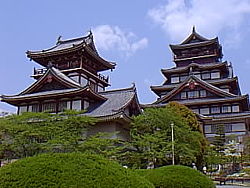- Fushimi Castle
-
Fushimi Castle
伏見城Fushimi-ku, Kyoto, Japan 
Fushimi Castle tenshuType Azuchi-Momoyama castle Built 1592-1594, rebuilt late 1590s, again in 1964 Built by Toyotomi Hideyoshi (original) Construction
materialsstone, wood, plaster, gold In use 1592-1623 Demolished 1596 by an earthquake; dismantled 1623 Current
conditionReconstruction closed to public Controlled by Toyotomi Hideyoshi (1592-1598), Torii Mototada (1598-1600), Tokugawa shogunate (1600-1623), Japan (1964-present) Fushimi Castle (伏見城 Fushimi-jō), also known as Momoyama Castle (桃山城 Momoyama-jō) or Fushimi-Momoyama Castle, is a castle in Kyoto's Fushimi Ward. The current structure is a 1964 replica of the original built by Toyotomi Hideyoshi.
Contents
History
The construction of the original castle was begun in 1592, the year after Hideyoshi's retirement from the regency, and completed in 1594. Twenty provinces furnished workers for the construction, which numbered between 20,000 and 30,000.
Though bearing the external martial appearance of a castle, the structure was intended as a retirement palace for Hideyoshi, and was furnished and decorated as such. It is particularly famous for its tea ceremony room in which both the walls and the implements were covered in gold leaf. The castle was intended to be the site for Hideyoshi's peace talks with Chinese diplomats seeking an end to the Seven-Year War in Korea, but an earthquake destroyed the castle entirely only two years after its completion.
It was rebuilt soon afterwards, and came to be controlled by Torii Mototada, a vassal of Tokugawa Ieyasu. In 1600, the castle fell in a famous and significant siege by Ishida Mitsunari. Torii Mototada, in a celebrated act of honor and bravery, defended the castle for eleven days, delaying Ishida's forces and allowing his lord Tokugawa time to build his own army. This had a profound effect on the Battle of Sekigahara, which came soon afterwards, and which marked the final victory of Tokugawa Ieyasu over all his rivals.
In 1623, the castle was dismantled, and many of its rooms and buildings were incorporated into castles and temples across Japan. A temple in Kyoto, Yōgen-in (養源院), has a blood-stained ceiling that had been the floor of a corridor at Fushimi Castle where Torii Mototada and company had committed suicide.
In 1912, the tomb of Emperor Meiji was built on the original site of the castle. The castle was not rebuilt until 1964, when a replica was created very nearby and primarily in concrete. The new structure served as a museum of the life and campaigns of Toyotomi Hideyoshi, but was closed to the public in 2003.
See also
- Jurakudai - Hideyoshi's previous luxurious residence from 1587–1594
References
- Sansom, George (1961). "A History of Japan: 1334-1615." Stanford, California: Stanford University Press.
- Turnbull, Stephen (2003). "Japanese Castles 1540-1640." Oxford: Osprey Publishing.
Further reading
- Bryant, Anthony J. (2005). Sekigahara 1600: The Final Struggle for Power. Praeger Publishers.
- Schmorleitz, Morton S. (1974). Castles in Japan. Tokyo: Charles E. Tuttle Co.. pp. 78–80. ISBN 0-8084-1102-4.
External links
- SengokuDaimyo.com : The website of Samurai Author and Historian Anthony J. Bryant. Accessed 4 April 2011.
Coordinates: 34°56′15″N 135°46′52″E / 34.937534°N 135.781194°E
Categories:- Castles in Kyoto Prefecture
- Buildings and structures completed in 1594
- Azuchi-Momoyama period
Wikimedia Foundation. 2010.


